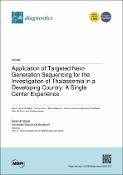Options
Application Of Targeted Next-generation Sequencing For The Investigation Of Thalassemia In A Developing Country: A Single Center Experience
Journal
Diagnostics
Date Issued
2023
Author(s)
Razan Hayati Zulkeflee
Rosnah Bahar
Marne Abdullah
Muhammad Amiro Rasheeq Mohd Radzi,
Alina Md Fauzi
Rosline Hassan
DOI
10.3390/diagnostics13081379
Abstract
Thalassemia is identified as a prevalent disease in Malaysia, known to be one of the developing countries. Fourteen patients with confirmed cases of thalassemia were recruited from the Hematology Laboratory. The molecular genotypes of these patients were tested using the multiplex-ARMS and GAP-PCR methods. The samples were repeatedly investigated using the Devyser Thalassemia kit (Devyser, Sweden), a targeted NGS panel targeting the coding regions of hemoglobin genes, namely the HBA1, HBA2, and HBB genes, which were used in this study. There were many different genetic variants found in 14 unrelated cases. Out of all fourteen cases, NGS was able to determine an additional -50 G>A (HBB:c.-100G>A) that were not identified by the multiplex-ARMS method, including HBA2 mutations, namely CD 79 (HBA2:c.239C>G). Other than that, CD 142 (HBA2:c.427T>C) and another non-deletional alpha thalassemia and alpha triplication were also not picked up by the GAP-PCR methods. We illustrated a broad, targeted NGS-based test that proposes benefits rather than using traditional screening or basic molecular methods. The results of this study should be heeded, as this is the first report on the practicality of targeted NGS concerning the biological and phenotypic features of thalassemia, especially in a developing population. Discovering rare pathogenic thalassemia variants and additional secondary modifiers may facilitate precise diagnosis and better disease prevention.
Subjects
File(s)
Loading...
Name
Application of Targeted NextGeneration Sequencing for the Investigation of Thalassemia in a Developing Country A Single Center Experience.pdf
Size
2.37 MB
Format
Adobe PDF
Checksum
(MD5):3bca4e57f2bdc0287cf3e56f568805dd